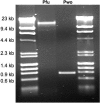Metabolic and evolutionary relationships among Pyrococcus Species: genetic exchange within a hydrothermal vent environment
- PMID: 16237032
- PMCID: PMC1272969
- DOI: 10.1128/JB.187.21.7492-7499.2005
Metabolic and evolutionary relationships among Pyrococcus Species: genetic exchange within a hydrothermal vent environment
Abstract
Pyrococcus furiosus and Pyrococcus woesei grow optimally at temperatures near 100 degrees C and were isolated from the same shallow marine volcanic vent system. Hybridization of genomic DNA from P. woesei to a DNA microarray containing all 2,065 open reading frames (ORFs) annotated in the P. furiosus genome, in combination with PCR analysis, indicated that homologs of 105 ORFs present in P. furiosus are absent from the uncharacterized genome of P. woesei. Pulsed-field electrophoresis indicated that the sizes of the two genomes are comparable, and the results were consistent with the hypothesis that P. woesei lacks the 105 ORFs found in P. furiosus. The missing ORFs are present in P. furiosus mainly in clusters. These clusters include one cluster (Mal I, PF1737 to PF1751) involved in maltose metabolism and another cluster (PF0691 to PF0695) whose products are thought to remove toxic reactive nitrogen species. Accordingly, it was found that P. woesei, in contrast to P. furiosus, is unable to utilize maltose as a carbon source for growth, and the growth of P. woesei on starch was inhibited by addition of a nitric oxide generator. In P. furiosus the ORF clusters not present in P. woesei are bracketed by or are in the vicinity of insertion sequences or long clusters of tandem repeats (LCTRs). While the role of LCTRs in lateral gene transfer is not known, the Mal I cluster in P. furiosus is a composite transposon that undergoes replicative transposition. The same locus in P. woesei lacks any evidence of insertion activity, indicating that P. woesei is a sister or even the parent of P. furiosus. P. woesei may have acquired by lateral gene transfer more than 100 ORFs from other organisms living in the same thermophilic environment to produce the type strain of P. furiosus.
Figures





Similar articles
-
A proposal to rename the hyperthermophile Pyrococcus woesei as Pyrococcus furiosus subsp. woesei.Archaea. 2004 Oct;1(4):277-83. doi: 10.1155/2004/513563. Archaea. 2004. PMID: 15810438 Free PMC article.
-
Divergence of the hyperthermophilic archaea Pyrococcus furiosus and P. horikoshii inferred from complete genomic sequences.Genetics. 1999 Aug;152(4):1299-305. doi: 10.1093/genetics/152.4.1299. Genetics. 1999. PMID: 10430560 Free PMC article.
-
Cloning and expression in Escherichia coli of the recombinant his-tagged DNA polymerases from Pyrococcus furiosus and Pyrococcus woesei.Protein Expr Purif. 1998 Oct;14(1):131-8. doi: 10.1006/prep.1998.0945. Protein Expr Purif. 1998. PMID: 9758761
-
Halophilic adaptation of protein-DNA interactions.Biochem Soc Trans. 2003 Jun;31(Pt 3):677-80. doi: 10.1042/bst0310677. Biochem Soc Trans. 2003. PMID: 12773181 Review.
-
Archaeon Pyrococcus kodakaraensis KOD1: application and evolution.Biotechnol Annu Rev. 1998;4:259-84. doi: 10.1016/s1387-2656(08)70073-5. Biotechnol Annu Rev. 1998. PMID: 9890143 Review.
Cited by
-
Microwave-Assisted Synthesis of Glycoconjugates by Transgalactosylation with Recombinant Thermostable β-Glycosidase from Pyrococcus.Int J Mol Sci. 2016 Feb 4;17(2):210. doi: 10.3390/ijms17020210. Int J Mol Sci. 2016. PMID: 26861292 Free PMC article.
-
DNA Processing Proteins Involved in the UV-Induced Stress Response of Sulfolobales.J Bacteriol. 2015 Sep;197(18):2941-51. doi: 10.1128/JB.00344-15. Epub 2015 Jul 6. J Bacteriol. 2015. PMID: 26148716 Free PMC article.
-
Flagella of Pyrococcus furiosus: multifunctional organelles, made for swimming, adhesion to various surfaces, and cell-cell contacts.J Bacteriol. 2006 Oct;188(19):6915-23. doi: 10.1128/JB.00527-06. J Bacteriol. 2006. PMID: 16980494 Free PMC article.
-
Evolution of mal ABC transporter operons in the Thermococcales and Thermotogales.BMC Evol Biol. 2008 Jan 15;8:7. doi: 10.1186/1471-2148-8-7. BMC Evol Biol. 2008. PMID: 18197971 Free PMC article.
-
Genome sequencing of a genetically tractable Pyrococcus furiosus strain reveals a highly dynamic genome.J Bacteriol. 2012 Aug;194(15):4097-106. doi: 10.1128/JB.00439-12. Epub 2012 May 25. J Bacteriol. 2012. PMID: 22636780 Free PMC article.
References
-
- Albers, S. V., S. M. Koning, W. N. Konings, and A. J. Driessen. 2004. Insights into ABC transport in archaea. J. Bioenerg. Biomembr. 36:5-15. - PubMed
-
- Amend, J. P., D. R. Meyer-Dombard, S. N. Sheth, N. Zolotova, and A. C. Amend. 2003. Palaeococcus helgesonii sp. nov., a facultatively anaerobic, hyperthermophilic archaeon from a geothermal well on Vulcano Island, Italy. Arch. Microbiol. 179:394-401. - PubMed
-
- Amend, J. P., K. L. Rogers, E. L. Shock, S. Gurrieri, and S. Inguaggiato. 2003. Energetics of chemolithoautotrophy in the hydrothermal system of Vulcano Island, southern Italy. Geobiology 1:37-58.
Publication types
MeSH terms
Substances
LinkOut - more resources
Full Text Sources
Molecular Biology Databases
Research Materials

